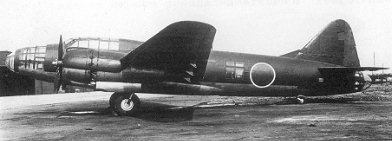|

|
One of the best-known Japanese aircraft of the war, the twin-engine G4M Type 1 medium bomber (allied code name Betty) performed in ways that rivaled many four-engine bombers. Almost 200 were in service at the time of the Pearl Harbor attack, and they operated wherever land bases were available to the Japanese. Twenty-six of these planes joined with G3M 'Nell' bombers to sink the Prince of Wales and Repulse. These aircraft flew against land and naval targets throughout the Pacific area, and near the end of the war were modified to carry Baka suicide aircraft. The Mitsubishi G4M was designed as the successor to the G3M 'Nell'; the prototype flew in Oct. 1939 and it was put into production that same month as the G6M1 long-range escort fighter. That project, however, was quickly abandoned with the thirty units completed being deployed as transports and trainers. In April 1941 the bomber version entered production. The much-improved G4M2 prototype flew in Nov. 1942. Total Betty production was 2,416 aircraft-more than any other Japanese bomber. These included 60 G4M3 variants with more protection, a fire extinguishing system, and more powerful engines, but the U.S. bombing raids disrupted production of these advanced aircraft. Late-production aircraft also had a surface-search radar. The mid-wing 'Betty' had a rounded appearance, with glazed nose and tail positions; it was a mid-wing aircraft with twin radial engines and a large tail fin. The excellent performance of the 'Betty' was achieved at the expense of armor for the crew and fuel tanks, making the aircraft highly vulnerable to attack.
|